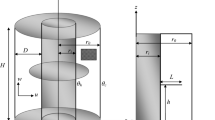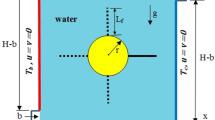Abstract
The free convection flow through a flexible baffle in an L-shaped enclosure has been numerically analyzed. The governing equations are introduced in an Arbitrary Lagrangian–Eulerian moving mesh frame. The full governing equations respect to boundary conditions were solved numerically using FEM. A grid-independent test was performed to ensure the accuracy of the results, and the results of the numerical solver are compared with previous works. The influence of the dimensionless parameters, including Rayleigh number, the elasticity modulus and the length of the flexible baffle investigated on the flow and heat transfer. Results indicate that a stiffer baffle tends to resist the fluid flow and inhibits convective heat transfer. For a higher value of Ra, a larger baffle results in more resistance to the flow and inhibits heat transfer, while, at the same time, increases the stress over the baffle.






















Similar content being viewed by others
Abbreviations
- g :
-
Gravity-constant vector
- L :
-
Height of the cavity
- W :
-
Width of the cavity
- B :
-
Length of the flexible baffle
- E :
-
Young’s modulus in dimensional form
- d s :
-
Vector of displacement
- f :
-
Frequency
- F v :
-
Vector of body force
- E τ :
-
Non-dimensional form of the elasticity modulus
- Pr :
-
Prandtl number
- P :
-
Fluid pressure
- k :
-
Thermal conductivity
- t :
-
Dimensional time
- Ra :
-
Thermal Rayleigh number
- w :
-
The vector of velocity for the mesh motion
- T :
-
Temperature
- u :
-
Velocity in a vector form
- y :
-
Cartesian coordinate in y direction
- x :
-
Cartesian coordinate in x direction
- ρ :
-
Density
- ν :
-
Poisson’s ratio
- σ :
-
Stress tensor, von Mises stress
- τ :
-
Non-dimensional time
- ρ R :
-
The ratio of the fluid’s density to the structure’s density
- β :
-
Volumetric thermal expansion coefficient
- μ :
-
Dynamic viscosity
- α :
-
Thermal diffusivity
- h :
-
Hot temperature
- av :
-
Average
- s :
-
Flexible baffle
- f :
-
Fluid
- c :
-
Cold temperature
- p :
-
Membrane partition
- *:
-
The parameters in a dimensional form
References
Shi X, Khodadadi J (2005) Periodic state of fluid flow and heat transfer in a lid-driven cavity due to an oscillating thin fin. Int J Heat Mass Transf 48(25–26):5323–5337
Shi X, Khodadadi J (2004) Fluid flow and heat transfer in a lid-driven cavity due to an oscillating thin fin: transient behavior. J Heat Transf 126(6):924–930
Jamesahar E, Ghalambaz M, Chamkha AJ (2016) Fluid–solid interaction in natural convection heat transfer in a square cavity with a perfectly thermal-conductive flexible diagonal partition. Int J Heat Mass Transf 100:303–319
Gomes JP, Lienhart H (2013) Fluid–structure interaction-induced oscillation of flexible structures in laminar and turbulent flows. J Fluid Mech 715:537–572
Al-Amiri A, Khanafer K (2011) Fluid–structure interaction analysis of mixed convection heat transfer in a lid-driven cavity with a flexible bottom wall. Int J Heat Mass Transf 54(17–18):3826–3836
Soti AK, Bhardwaj R, Sheridan J (2015) Flow-induced deformation of a flexible thin structure as manifestation of heat transfer enhancement. Int J Heat Mass Transf 84:1070–1081
Sabbar WA, Ismael MA, Almudhaffar M (2018) Fluid-structure interaction of mixed convection in a cavity-channel assembly of flexible wall. Int J Mech Sci 149:73–83
Joshi RU, Soti AK, Bhardwaj R (2015) Numerical study of heat transfer enhancement by deformable twin plates in laminar heated channel flow. Comput Thermal Sci Int J 7:5–6
Park SG, Chang CB, Kim B, Sung HJ (2017) Simulation of fluid-flexible body interaction with heat transfer. Int J Heat Mass Transf 110:20–33
Alsabery A, Sheremet M, Ghalambaz M, Chamkha A, Hashim I (2018) Fluid–structure interaction in natural convection heat transfer in an oblique cavity with a flexible oscillating fin and partial heating. Appl Thermal Eng 145:80–97
Alsabery A, Selimefendigil F, Hashim I, Chamkha A, Ghalambaz M (2019) Fluid-structure interaction analysis of entropy generation and mixed convection inside a cavity with flexible right wall and heated rotating cylinder. Int J Heat Mass Transf 140:331–345
Mehryan S, Chamkha A, Ismael M, Ghalambaz M (2017) Fluid–structure interaction analysis of free convection in an inclined square cavity partitioned by a flexible impermeable membrane with sinusoidal temperature heating. Meccanica 52(11–12):2685–2703
Chamkha AJ, Miroshnichenko IV, Sheremet MA (2018) Unsteady conjugate natural convective heat transfer and entropy generation in a porous semicircular cavity. J Heat Transf 140(6):062501
Chamkha AJ, Miroshnichenko IV, Sheremet MA (2017) Numerical analysis of unsteady conjugate natural convection of hybrid water-based nanofluid in a semicircular cavity. J Thermal Sci Eng Appl 9(4):041004
Tayebi T, Chamkha AJ (2019) Entropy generation analysis during MHD natural convection flow of hybrid nanofluid in a square cavity containing a corrugated conducting block. Int J Numer Methods Heat Fluid Flow 30(3):1115–1136
Kumar B, Seth G, Nandkeolyar R, Chamkha A (2019) Outlining the impact of induced magnetic field and thermal radiation on magneto-convection flow of dissipative fluid. Int J Thermal Sci 146:106101
Dogonchi A, Armaghani T, Chamkha AJ, Ganji D (2019) Natural convection analysis in a cavity with an inclined elliptical heater subject to shape factor of nanoparticles and magnetic field. Arabian J Sci Eng 44(9):7919–7931
Alsabery A, Mohebbi R, Chamkha A, Hashim I (2019) Impacts of magnetic field and non-homogeneous nanofluid model on convective heat transfer and entropy generation in a cavity with heated trapezoidal body. J Therm Anal Calorim 138(2):1371–1394
Sardari PT, Babaei-Mahani R, Giddings D, Yasseri S, Moghimi M, Bahai H (2020) Energy recovery from domestic radiators using a compact composite metal Foam/PCM latent heat storage. J Clean Prod 257:120504
Shahsavar A, Goodarzi A, Mohammed HI, Shirneshan A, Talebizadehsardari P (2020) Thermal performance evaluation of non-uniform fin array in a finned double-pipe latent heat storage system. Energy 193:116800
Shahsavar A, Khosravi J, Mohammed HI, Talebizadehsardari P (2020) Performance evaluation of melting/solidification mechanism in a variable wave-length wavy channel double-tube latent heat storage system. J Energy Storage 27:101063
Mahdi JM, Mohammed HI, Hashim ET, Talebizadehsardari P, Nsofor EC (2020) Solidification enhancement with multiple PCMs, cascaded metal foam and nanoparticles in the shell-and-tube energy storage system. Appl Energy 257:113993
Sardari PT, Grant D, Giddings D, Walker GS, Gillott M (2019) Composite metal foam/PCM energy store design for dwelling space air heating. Energy Convers Manag 201:112151
Sardari PT, Giddings D, Grant D, Gillott M, Walker GS (2020) Discharge of a composite metal foam/phase change material to air heat exchanger for a domestic thermal storage unit. Renew Energy 148:987–1001
Arshad A, Jabbal M, Sardari PT, Bashir MA, Faraji H, Yan Y (2020) Transient simulation of finned heat sinks embedded with PCM for electronics cooling. Therm Sci Eng Prog 18:100520
Selimefendigil F, Öztop HF (2020) Control of natural convection in a CNT-water nanofluid filled 3D cavity by using an inner T-shaped obstacle and thermoelectric cooler. Int J Mech Sci 169:105104
Ahmed SY, Ali FH, Hamzah HK (2018) Heatlines visualization of natural convection in trapezoidal cavity filled with nanofluid and divided by porous medium partition. Comput Fluids. https://doi.org/10.1016/j.compfluid.2018.12.004
Armaghani T, Kasaeipoor A, Izadi M, Pop I (2018) MHD natural convection and entropy analysis of a nanofluid inside T-shaped baffled enclosure. Int J Numer Methods Heat Fluid Flow 28(12):2916–2941
Esfe MH, Arani AAA, Yan W-M, Aghaei A (2017) Natural convection in T-shaped cavities filled with water-based suspensions of COOH-functionalized multi walled carbon nanotubes. Int J Mech Sci 121:21–32
Morsli S, Sabeur A, El Ganaoui M (2017) Influence of aspect ratio on the natural convection and entropy generation in rectangular cavities with wavy-wall. Energy Proc 139:29–36
Li Z, Barnoon P, Toghraie D, Dehkordi RB, Afrand M (2019) Mixed convection of non-Newtonian nanofluid in an H-shaped cavity with cooler and heater cylinders filled by a porous material: two phase approach. Adv Powder Technol 30(11):2666–2685
Miroshnichenko IV, Sheremet MA, Oztop HF, Al-Salem K (2016) MHD natural convection in a partially open trapezoidal cavity filled with a nanofluid. Int J Mech Sci 119:294–302
Mohebbi R, Mehryan S, Izadi M, Mahian O (2019) Natural convection of hybrid nanofluids inside a partitioned porous cavity for application in solar power plants. J Therm Anal Calorim 137(5):1719–1733
Selimefendigil F, Öztop HF (2019) MHD mixed convection of nanofluid in a flexible walled inclined lid-driven L-shaped cavity under the effect of internal heat generation. Phys A Stat Mech Appl 534:122144
Mahmoodi M (2011) Numerical simulation of free convection of a nanofluid in L-shaped cavities. Int J Therm Sci 50(9):1731–1740
Ma Y, Mohebbi R, Rashidi M, Yang Z (2018) Simulation of nanofluid natural convection in a U-shaped cavity equipped by a heating obstacle: effect of cavity’s aspect ratio. J Taiwan Inst Chem Eng 93:263–276
Fard AH, Hooshmand P, Mohammaei M, Ross D (2019) Numerical study on free convection in a U-shaped CuO/water nanofluid-filled cavity with different aspect ratios using double-MRT lattice Boltzmann. Therm Sci Eng Prog 14:100373
Chamkha A, Ismael M, Kasaeipoor A, Armaghani T (2016) Entropy generation and natural convection of CuO-water nanofluid in C-shaped cavity under magnetic field. Entropy 18(2):50
Zargartalebi H, Ghalambaz M, Chamkha A, Pop I, Nezhad AS (2018) Fluid–structure interaction analysis of buoyancy-driven fluid and heat transfer through an enclosure with a flexible thin partition. Int J Numer Methods Heat Fluid Flow 28:2072–2088
Donea J, Huerta A (2003) Finite element methods for flow problems. Wiley, Hoboken
Zhang Q, Hisada T (2001) Analysis of fluid–structure interaction problems with structural buckling and large domain changes by ALE finite element method. Comput Methods Appl Mech Eng 190(48):6341–6357
De Los Reyes JC, González Andrade S (2012) A combined BDF-semismooth Newton approach for time-dependent Bingham flow. Numer Methods Partial Differ Equ 28(3):834–860
Wriggers P (2008) Nonlinear finite element methods. Springer, Berlin
Schenk O, Gärtner K (2004) Solving unsymmetric sparse systems of linear equations with PARDISO. Future Gener Comput Syst 20(3):475–487
Verbosio F, De Coninck A, Kourounis D, Schenk O (2017) Enhancing the scalability of selected inversion factorization algorithms in genomic prediction. J Comput Sci 22:99–108
Calcagni B, Marsili F, Paroncini M (2005) Natural convective heat transfer in square enclosures heated from below. Appl Therm Eng 25(16):2522–2531
Xu F, Patterson JC, Lei C (2009) Heat transfer through coupled thermal boundary layers induced by a suddenly generated temperature difference. Int J Heat Mass Transf 52(21–22):4966–4975
Küttler U, Wall WA (2008) Fixed-point fluid–structure interaction solvers with dynamic relaxation. Comput Mech 43(1):61–72
Acknowledgements
The authors are grateful to the financial support received from the Malaysian Ministry of Education research Grant FRGS/1/2019/STG06/UKM/01/2.
Author information
Authors and Affiliations
Corresponding author
Ethics declarations
Conflict of interest
The authors declare that they have no conflict of interest.
Additional information
Publisher's Note
Springer Nature remains neutral with regard to jurisdictional claims in published maps and institutional affiliations.
Rights and permissions
About this article
Cite this article
Ghalambaz, M., Mehryan, S.A.M., Alsabery, A.I. et al. Controlling the natural convection flow through a flexible baffle in an L-shaped enclosure. Meccanica 55, 1561–1584 (2020). https://doi.org/10.1007/s11012-020-01194-2
Received:
Accepted:
Published:
Issue Date:
DOI: https://doi.org/10.1007/s11012-020-01194-2




